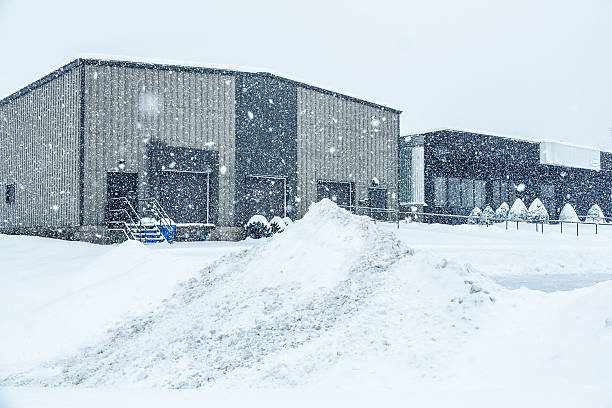Winter Threats to Employee Safety
As the winter season begins to settle in, we encounter risks that come with the changing weather. Equipping yourself to confront the diverse challenges posed by severe cold and winter weather is essential for mitigating the potential effects on your workforce, clientele, and overall financial performance. Through readiness and clear communication, you can enhance the resilience of our business during the cold winter months, ensuring a more manageable experience for both you and your employees.
When snow and ice strike, driving conditions can quickly deteriorate. According to the Federal Highway Administration, over 1,300 people are killed and more than 116,800 are injured in vehicle crashes due to winter weather conditions each year. And it’s not just icy roads and snow accumulation that companies need to worry about.
Many winter hazards affect businesses, even in areas that don’t experience snow. An increased likelihood of dangerous fire activity, slip and fall injuries, and the flu and other seasonal illnesses are just a few risks most companies, regardless of location, face when winter arrives. Prior to the onset of the pandemic, illnesses associated with the workplace, such as the flu, resulted in employers losing billions annually in terms of productivity.
Most common cold-weather safety hazards
According to OSHA’s winter safety precautions, there are a variety of weather-related hazards employees may be exposed to during winter. They include dangerous driving conditions and the risks that come with shoveling snow and working outdoors in the elements.
While the specific hazards vary by location, industry, and the nature of your business activities, threats your people may face this winter can include:
- Unsafe winter driving conditions
- Road closures
- Slip and fall injuries
- Snow shoveling health risks
- Hypothermia and frostbite
- Flu, COVID-19, and other seasonal illnesses
- Local school delays and closures
- Fire activity
- Power outages
Winter Weather Safety Tips
- Use technology to monitor winter threats
From storm-related outages to local disease outbreaks, it’s vital to keep a pulse on all potential threats that could impact your people or facility. But trying to monitor road closures, fires, icy conditions, temperatures, and weather forecasts all at once is more than a full-time job. Plus, it gets more difficult when you have multiple office locations to account for and traveling employees.
Thankfully, there are many helpful apps available to download on your smartphone or tablet so that weather-related news is available at your fingertips. Download your local news app to stay updated on closures, outages, or outbreaks, as well as the Nebraska 511 or KanDrive apps to be aware of road conditions and closures.
- Maintain a facility safe from winter hazards
Falls involving ice, sleet, or snow are some of the biggest risks people face during the winter months. In 2017 alone, there were more than 20,000 occupational injuries related to ice, sleet, and snow – and those are just the falls that were reported! If your building has gas lines, there are also carbon monoxide poisoning risks in the event a line breaks.
Winter preparedness is essential to protecting our team, and steps must be taken to prepare our facilities. You can’t prevent all falls, but you can salt the parking lot, sidewalks, and steps ahead of time. You can also place large, absorbent mats at every entrance to prevent slips once employees are inside the building.
Specific steps you can take to improve winter workplace safety include:
- Inspecting your facilities (roof, plumbing, etc.)
- Performing all required preventative maintenance and repairs
- Keeping walkways well-lit and clearly marked
- Ensuring you have a reliable contractor for snow removal
- Maintaining an adequate supply of de-icing products for walking surfaces
- Providing employees with slip-resistant footwear
- Installing carbon monoxide detectors to monitor for leaks
- Familiarizing yourself with OSHA winter safety tips and resources
- Clearly communicate plans to employees
During severe winter storms, utility outages that knock out heat, power, and communication services can last for hours and sometimes even days. Have a plan for how employees are expected to continue to work in the event of an outage, as well as how you will stay in touch with your team – and be sure everybody is clear on those plans ahead of time. Your people are going to expect communication before, during, and after any big storm. Don’t leave them hanging! Here are some of the things your employees are likely to wonder about in a winter emergency:
- Commute options
- Power outages or surge impacts
- Emergency contact information
- Modifications to work hours and/or shifts
- Access to updates
- Review winter safety topics
Keep winter safety top of mind by regularly holding brief meetings to discuss bite-size topics. This could be a safety talk before a shift to caution workers to avoid cold-weather injuries and hazards. It could be a planned discussion before a snowstorm is predicted to hit so that you can remind employees of safe driving tips. Here are some other winter safety topic ideas:
- Frostbite prevention and care
- Safe use of space heaters
- Cold-weather equipment handling
- Communication procedures for storm warnings and workplace closures
- How to recognize hypothermia
Read more winter safety tips at www.alertmedia.com/blog/winter-workplace-safety-tips.

